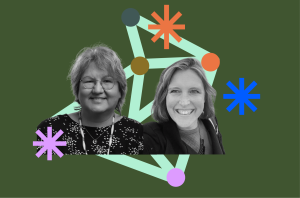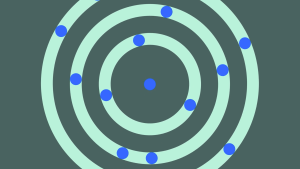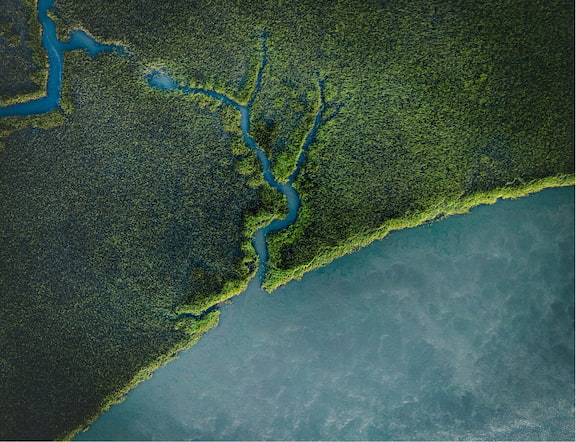- Getting started
- What object or prop would use to help describe a system?
- How do you understand how systems change?
- What is a definition you use to help people understand systems change?
- What are your lineages into systemic practice?
- What are your best examples of systemic transformation?
- How are you creating or seeking transformation?
- How is your practice systemic?
Getting started
Melanie Goodchild is an Anishinaabe (Ojibway) systems thinking and complexity scholar. She is part of the faculty at the Academy for Systems Change, the Presenting Institute’s u-school for Transformation and the Wolf Willow Institute for Systems Learning.
This dialogue explores Melanie’s lineages into systems practice, along with the Anishinaabe concepts of anishinaabe gikendaasowin, our original ways of knowing and gidinawendimin, that we are all related.

Anna
Welcome, Melanie. I’d love you to introduce yourself fully, and then we’ll get into the questions.
Melanie
Boozhoo nindinawemaaganidok, greetings to all of my relatives. My two spirit names are Waabishki Ogichidakwenz-anang and Waaba-anang ikwe indigoo Anishinabemong idash. I'm Moose Clan and also known in English as Melanie Goodchild.
I'm here in Baawaating, the place of the rapids. It's located in the Three Fires Confederacy territory of the Anishinaabe, Potawatomi and Odawa peoples. I am an Anishinaabe woman, also known as Ojibway, Saulteaux, or Chippewa in English. And this place where I am joining you from is called Sault Saint Marie, Ontario in colonial geography.
It's the traditional territory of Baawaating First Nation. My mom is from Kitigan Zibi, which is about five minutes from here. My dad was from Biigtigong Anishinaabe, which is about four hours from here. I always introduce myself with those protocols so that you know who I am and where I'm coming from today, where I'm actually broadcasting from.
What is a system? What metaphors do you use to help describe systems?
Anna
Wonderful, thank you. From your perspective, what is a system? What are some of the metaphors you regularly refer to in this work?
Melanie
I come from the practice of learning about systems thinking through a decolonizing lens, and I often sit with other systems thinkers including elders and language speakers, indigenous elders and language speakers.
So one of the first things I would say is that, when we define it in English, a system is a noun. It’s part of "nounification", as my brother and colleague Tiokasin Ghosthorse, who's Lakota, often talks about.
English tends to thingify the world. It's a language of distancing. When we thingify and nounify a system, it's over there. Somehow I think that definition does us a disservice, when the first thing we often teach people is that we are part of the systems we're trying to transform. So from my perspective, a system is a living set of relationships, it's a living being. It has a spirit. There are non-humans and humans involved in those relations. It's about interconnectivity and relationships. And so from anishinaabe gikendaasowin, which means our original ways of knowing, from that perspective, a system is not a system. It's a series of living beings in relationships. It's not a noun.
What object or prop would use to help describe a system?
Anna
Lovely. And if you were to bring an object or a prop to the conversation that would help describe what this living system is, what would it be?
Melanie
I was thinking about this question, and want to go back to my first description of a system being a living being and a spirit consisting of non-humans and humans. What I've brought as a helper is not an object or a prop, it's a spirit being and it's a turtle rattle.
In this aadizookaan, traditional story or sacred story, which means it's cognizant of the fact it is being told as a story, it is the legend of this particular shaker, this turtle rattle. Mikinak zhiishiigwan - zhiishiigwan means rattle, mikinak is turtle.
This turtle rattle is red on the left for the heart and white on the right for the mind. There are 28 moons around the outside, 13 moons on the inside of all the turtle shells. That's our traditional calendar, we have 13 months.
Inside are 13 manidoog, 13 little rocks. They were collected at a place of my ancestors where there are thunder beings. The handle has been struck by lightning and that coloring comes from some paint that was a gift to me from the collection of an elder that's passed in Stoney Nakoda territory. And so really there's a contribution here of the four directions in this object or being.
The reason I bring this helper when I'm talking about systems and complexity is because it's a balance between the heart and mind. When we shake it's a healing rattle. Often when you're surfacing mental models and you're trying to transform or shift the status quo, there's a lot of healing that happens. And healing self, I think, is how you begin to do systems work. And so this rattle has been my helper. It listens to the stories, I pass it around in circle when I'm talking with people.
But it can also work at the level of a metaphor or a heuristic for understanding systems because it is a system in itself as a being. And so you can't really understand it by all those parts I described. You can't understand it by the shell or the handle or the colors. It has to all work together and it all works together as a healer and it really begins to work when you hear the sound of it.
That's why I wouldn't call it an object, but I bring it all the time when I talk about systems and systems change.
How do you understand how systems change?
Anna
Again, thank you. So how do you understand how systems change happens?
Melanie
When I was first introduced to the adaptive cycle and panarchy theory I understood the phases of a system and that there was agency within that. That helped me understand transitions in complexity.
But from anishinaabe gikendaasowin, our original ways of knowing, I've been yarning, which is having dialogues with elders and language speakers. In yarning with the elders, I ended up writing my own story of my apprenticeship with complexity called niigani miinigowiziiwin, which means the gifts that we give to the future.
The elders define what we're doing in terms of systems change, and how that change happens, as clearing the pathway for the beings yet to come, all the beings yet to come. That is the practice of what we might call ‘building the container’, creating the conditions for the emerging future.
All of these tools, technologies and methodologies that we have as systems change practitioners, for the elders - it's clearing the path for those yet to come. It's done out of a place of love and concern for the beings of the future who hear our distress. And so the elders told me, "Melanie, when you shake your mikinak zhiishiigwan, when you shake your turtle rattle, they hear your distress and the change starts when the spirits start to do their work."
What is a definition you use to help people understand systems change?
Anna
Thank you. Do you have a definition you use for systems change then?
Melanie
We don't really have definitions. I think definitions come with the colonial nature of the English language, the distancing, the objectification, the thingification of things.
Most of our Anishinaabemowin, our original language, is verb-based, but there is a concept that I think is part of the underlying teaching of anything around systems and complexity. And it's gidinawendimin, we are all related. It’s our kinship system. It's about how we were created and put here on the lands of the Anishinaabe, Shkakmigkwe, Mother Earth.
It's very different to look at the world from that perspective, to engage and make sense and make meaning of the world from the perspective of that tree, that river, that mountain.
So all of our ideas, our thought processes, the way we describe things, those are living beings and they all have an energy. We feed them, we feast them, we sit with them and drink water and feed them berries. And so if we're looking for some type of a definition of systems change and how that happens, it happens through the relationships of gidinawendimin.
And it also I think happens through quite a bit of healing. I think a lot of systems transformation comes out of trauma, comes out of pain, comes out of turning those really negative and undesirable outcomes of these big systems that we have into a healing process.
What are your lineages into systemic practice?
Anna
Thank you. I guess you've mentioned some of this, but it's no harm asking again, what is your lineage and lineages into this practice?
Melanie
Yeah, I think my first lineage comes from being Anishinaabe, from the perspective of my ancestors here on Turtle Island, which is North America. We have all kinds of teachings. We have mashkiki or mashkikiwan, which is medicine. My culture is about a relationship with all of those medicines, those helpers, those spirit beings.
And that concept of gidinawendimin, that we are all related, is really a deep systems perspective. It's about the interconnectivity of all beings, but it's not as anthropocentric as some of the other lineages I have - for example studying systems thinking, systems dynamics and complexity in my doctoral studies.
I'm doing a PhD in social and ecological sustainability at the University of Waterloo. I've since joined the faculty of a few different leaders in systems thinking: the Academy for Systems Change and the Center for Systems Awareness at MIT with Peter Senge, the Presencing Institute with Otto Scharmer and the Wolf Willow Institute for Systems Learning.
I think about what I've done to reconcile those very distinct lineages, which are both about holistic thinking, but one comes out of a predominantly academic, intellectual, coming out of the enlightenment within science, while a response to the compartmentalization and reductionism of the holistic thinking of my ancestors.
And there's a space in between that I’ve called ‘relational systems thinking’ in a paper that I wrote. And it's really about the idea that you can have two separate and distinct lineages, with a space in between. Willie Ermine, a Cree scholar, has called it an ethical space. My Uncle Dan Longboat called it a sacred space between different ways of knowing.
And that to me is where I introduce people. A shift in consciousness. I think it's really about healing and those divergent histories and lineages.
For me, I'm a systems geek. I really enjoy learning about the tools and methodologies of doing systems practice, but I always come at it from the perspective that for me what comes first is anishinaabe gikendaasowin, our original ways of knowing.
To help me do that, I spent a lot of time with elders. I spent a lot of time on the land and in ceremony and a lot of time with language speakers because our languages I think really codify that holistic worldview. And so everything for me comes back to the language. That's why niigani miinigowiziiwin, is miinigo that wiziiwin, from somebody else, is your sacred knowledge bundle. And so for these lineages, all of those are part of my sacred knowledge bundle, whether I got a degree in it or I went to a ceremony. That's all an important part of my knowledge bundle.
I can give one example from indigenous food systems, where regenerative practices or a circular kind of concept were ingrained in agriculture and cultivation in the pre-independence era. And we've systematically lost that because of the green revolution and the many changes that took place in the structures, processes and methodology of how agriculture is done.
Anna
Thank you. And part of our task here is also asking the question, how do we help reconcile and understand, without recolonizing and creating harm. Is there anything else you want to say about these divergent and different histories within these systemic practices, anything else we should help people be aware of?
Melanie
I think a really important entry point for shifting consciousness is to have an open mind and an open heart towards anishinaabe gikendaasowin, our original ways of knowing, which - at first appears very different from something like science or systems dynamics - is to go out onto the land. And that I can't kind of overstate enough how healing that is for people. The disconnection that society in general has had from the land, but to really be with the land and learn from the waters, what the trees are teaching you.
In this story I wrote, niigani miinigowiziiwin, I say "Go up high and look for your relatives, Grandfather Birch and Grandmother Cedar because they will give you everything you need. They will guide you home." That's true from an ecological perspective. Grandmother Cedar likes to grow where she plants her feet in the water, so you will find a water source. Grandfather Birch does not get struck by lightning. That's why my ancestors built our traditional lodges out of that particular tree.
What seems like potentially simple, local knowledge is really universal. For some that might be a metaphor. I don't expect that people will go high and look for those trees if those trees are nowhere near and they're in the desert or they're by the ocean. But the idea of in the particular is the universal, and in the universal is the particular. The elders talk about that quite often.

At first I was tempted and really pressured in some ways to be pan-indigenous, to make something more palatable to folks from a cross-cultural perspective. But I've since learned that the more particular I am about being Anishinaabe and our language Anishinaabemowin, that that's actually what's helpful to introduce people to this approach: that there are other ways of thinking about systems and complexity that isn't necessarily just the lineage of what you might study at university.
And there teaching in the medicine wheel that has four quadrants and four colors: red, black, yellow, and white. It's the four directions, and the four parts of your being; spiritual, mental, physical, and emotional.
Embodied practices are really key to introducing a shift in consciousness. We tend to neglect that. We've done things like Cha Gong, hikes in the bush, walking, going out on the water. We also have our traditional teas and foods, because the elders say for human beings, if knowledge is being shared with you, that you have to eat or drink something at the same time, to ingest and metabolize what's being shared. So that's our methodology. I say we, me and the elders and other people I work with, is to sit down and have a cup of tea by the fire. And that's the best way to introduce different lineages of systems.
What are your best examples of systemic transformation?
Anna
Thank you. Moving into your examples of systemic transformation, what's your story of systemic transformation?
Melanie
When I think of systemic transformation, I'm cognizant of the fact that when we talk about systems change in the field, we're often talking about population level, large scale, global transformative change.
But I also think that change happens within the individual. And that's where I focus a lot of my energy, in that inner work, the interior condition of the innovator, this idea that systemic transformation happens when there's a collective practice, when people are on a collective wisdom journey and start to look for those leverage points. I think that some of the best examples of systemic transformation are of those shifts in mental models, and if someone has agency and power within the system to bring others along.
A specific example in the Canadian context, are the residential school survivors and the Indian Residential School Survivors Society. This was a genocidal policy created by the Canadian government, where we had residential schools run by the churches as part of the colonizing process. They were not talked about for many, many years. And then the residential school survivors fought a truth and reconciliation commission here in Canada.
Through reconciliation and truth telling there's a window of opportunity for organizations, for society in general, to address our colonial history, particularly terra nullius and The Doctrine of Discovery. Most Canadians don't learn that in school. I didn't learn about the colonial foundation of this country that's known as Canada or the United States.
And so I think truth telling is a beautiful part of systemic transformation. We have a storytelling project right now with some elders and language speakers and folks working on the opioid crisis in our communities here, our first nation communities. There's an elder that said, "We don't really tell stories, we tell the truth. Let's not call this storytelling, let's call it truth telling." I think where truth telling happens, systemic transformation happens.
How are you creating or seeking transformation?
Anna
Lovely, thank you. And, where and how are you creating or seeking that transformation?
Melanie
I think in the work I do with colleagues, facilitators and others that lead systems transformation work, whether it's Theory U or at the Wolf Willow Institute for Systems Learning, we've really been exploring what we call the ‘edges of complexity’.
We host something called the Cafe at the Edge of the World, which is all online. I hosted people on the land via Zoom. My husband works the iPhone and follows me. I have earbuds and I take people on a walk through the woods of complexity, which are our sacred lands here at my brother Keith Boissoneau's home.
And when I say sacred, it's our ceremonial ground. Our fasting lodges are there, the tepees, the sweat lodge where we have our ceremonies. And as people took a walk in the woods of complexity with me, I introduced them to Grandfather Birch and Grandmother Cedar and I talked about how that shift in consciousness is maybe where they can begin to start thinking about complexity.
I think gidinawendimin, we are all related, is a complexity mindset. It was a gift from my ancestors. The complexity mindset aspires to holistic thinking or irreducible wholeness. I see a resonance in more conventional Western university-based systems thinking, but it is still very anthropocentric.
How can we have irreducible wholeness if humans are separate and not only separate but in a hierarchy? It’s about transcending binary thinking and transcending hierarchical thinking. Those are two of the main ingredients of what I try to cook up when I take people out onto the land. That's how I'm sort of seeking to create transformation. It really starts with the individual.
How is your practice systemic?
Anna
You've described your practice, what is it about it that’s systemic?
Melanie
My practice is not a solo practice, I do this with other collaborators, other folks, other facilitators, folks in the field, storytellers, elders.
It's systemic because it's collective, it's systemic because it's about relationships first over other things like hierarchy and the status quo of how someone does business for example. There's deep hospitality, a lot of art.
Recently, I don't think I could call any type of practice systemic if there's not an artist involved. We've had artists and residents that sing songs, that create poems, that draw. So some of it's scribing, but some of it is like creating art out of what's being talked about systemically.
We introduce people to feedback loops, the iceberg model and different tools, but it's really about embodying that. So there's certainly 3D and 4D mapping and Arawana Hayashi's practices like Social Presencing Theater. But we take people out onto the land, whether it's virtually or right here in person. We go out and experience what nature teaches us about systems and complexity and spirituality in this sacred circle of the four parts of your being; spiritual, mental, physical, emotional.
It's important to do the physical. That's what our ceremonies do. It's important for the mental, that's what storytelling and dialogue is. That's what truth telling is. And so I think the practice that I've hopefully been able to introduce some people to, even if we're somewhere that I'm where I'm not from, if I'm in a big city or I'm on another continent, I try to find the land and hopefully we at least go for a walk and we start to appreciate what the season is, what time of day it is, and then people use all of their senses to be in relationship with that. That I think is a systemic practice.
Enjoyed this Systems Dialogue? Meet the rest of our contributors or dig deeper with our Stepping into Systems film series.





